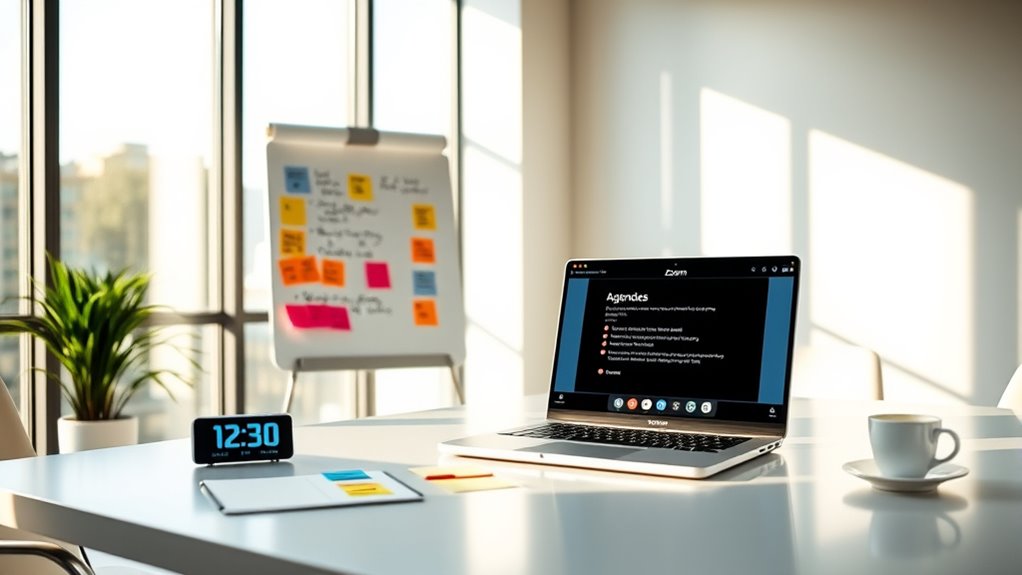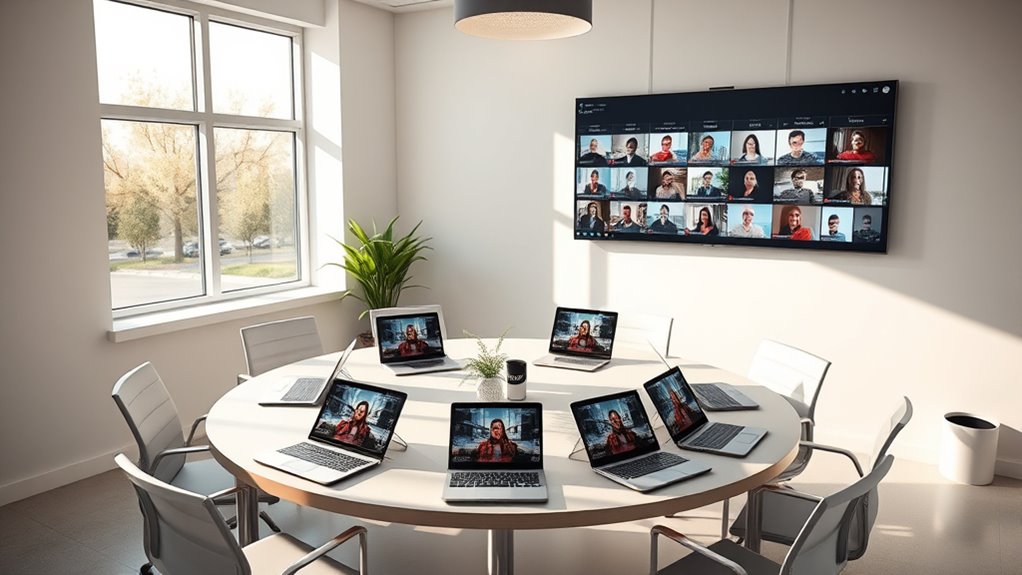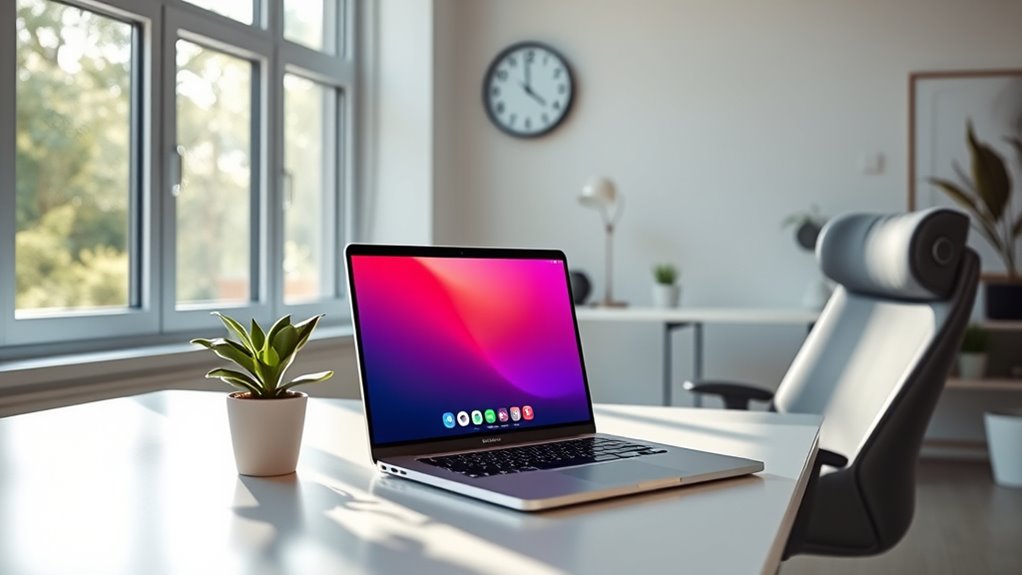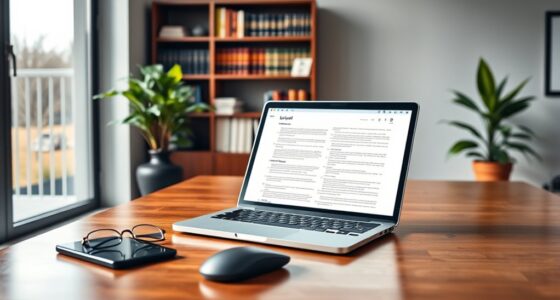To reduce Zoom fatigue, set clear goals and structured agendas to keep meetings focused and efficient. Limit meeting lengths and avoid back-to-back sessions, giving your team time to recharge. Incorporate breaks, movement, and mindfulness to boost alertness. Use engaging visuals and encourage participation through interactive tools, but consider shifting some updates to asynchronous channels like email or chat to lessen screen time. Keep exploring these strategies to create balanced, more effective meetings.
Key Takeaways
- Limit meeting duration and frequency to reduce prolonged screen time and cognitive overload.
- Incorporate regular breaks, movement, and mindfulness to refresh participants and decrease fatigue.
- Use engaging visuals, clear agendas, and interactive tools to maintain focus and participation.
- Promote asynchronous communication for updates and decisions, minimizing the need for continuous live meetings.
- Design meetings with structured roles and small group activities to foster engagement and reduce fatigue.
Set Clear Objectives and Agendas

To reduce Zoom fatigue, it’s essential to set clear objectives and agendas before each meeting. When you define what you want to accomplish, you create a roadmap that keeps everyone focused. This improves effective communication, ensuring that discussions stay relevant and on track. Use engagement strategies like asking targeted questions or assigning roles to encourage participation. A well-structured agenda helps participants prepare in advance, reducing confusion and unnecessary tangents. Clear objectives also help you manage meeting length, preventing fatigue from prolonged or unfocused sessions. Additionally, incorporating visual cues can enhance engagement and retention during virtual meetings. By communicating purpose early, you foster a sense of purpose and involvement, making meetings more productive and less draining. This simple step lays the foundation for more efficient, engaging virtual interactions.
Limit Meeting Duration and Frequency

Limiting the duration and frequency of meetings is essential for preventing Zoom fatigue. Shorter meetings help maintain focus and energy, so set clear time limits and stick to them. Encourage good meeting etiquette by starting and ending on time, and avoiding unnecessary gatherings. Consider consolidating multiple discussions into fewer, more efficient sessions. Technology upgrades, like reliable video conferencing tools, can streamline interactions and reduce technical disruptions that drain participants’ energy. Be mindful of participants’ schedules by avoiding back-to-back meetings, which can increase fatigue. Regularly evaluating your meeting schedule and adjusting it based on team needs promotes healthier work habits. Additionally, incorporating engaging meeting formats can keep participants more attentive and reduce exhaustion. By setting reasonable limits and respecting everyone’s time, you help foster a more engaged and less exhausted virtual team.
Incorporate Breaks and Movement

Incorporating breaks and movement into your virtual meetings can considerably reduce fatigue and boost participants’ focus. Schedule regular stretch breaks to help everyone reset and alleviate stiffness from prolonged sitting. Encourage quick movement activities, like standing up, stretching, or walking around, to increase circulation and energy levels. Short breaks of one to two minutes every 20-30 minutes make a significant difference in maintaining attention. You might also assign simple exercises or movements that participants can do at their desks. These activities help combat the mental drain associated with continuous screen time and keep engagement high. By intentionally integrating breaks and movement, you create a more dynamic meeting environment that supports mental alertness and reduces burnout. Incorporating mindfulness practices during these pauses can further enhance focus and reduce stress.
Optimize Visual Engagement and Presentation

Enhancing visual engagement and presentation techniques keeps participants attentive and helps convey your message more effectively. Focus on maintaining high visual clarity by using clear, high-resolution visuals and minimizing clutter on slides. Your presentation style should be simple, consistent, and easy to follow, avoiding overly busy or complex slides that distract viewers. Use contrasting colors and legible fonts to ensure everyone can see content clearly, even on smaller screens. Keep visuals relevant and purposeful, supporting your key points without overwhelming the audience. Incorporate varied visuals like images, charts, and videos to break monotony and sustain interest. Being aware of regional differences in legal resources can also help tailor your presentation to specific audiences and contexts. By refining your visual approach, you help participants stay engaged and absorb information more efficiently, reducing fatigue and fostering a more effective virtual meeting experience.
Encourage Participation and Interaction

To keep participants engaged, you can use interactive tools like polls and chat features to facilitate input. Promoting small group work allows for more meaningful conversations and reduces the pressure of speaking in large sessions. Implementing structured agendas helps everyone stay focused and ensures all voices are heard throughout the meeting. Incorporating visual aids such as high-quality projectors can also enhance understanding and maintain attention.
Use Interactive Tools
Using interactive tools during virtual meetings can substantially reduce Zoom fatigue by fostering engagement and creating a sense of connection. Incorporate virtual icebreakers to loosen participants and build rapport. Use polling techniques to gather instant feedback and keep attendees involved. Additionally, leverage chat functions to encourage real-time questions and comments, making the session more dynamic. Finally, consider shared digital whiteboards or collaborative documents to facilitate active participation. These tools make the meeting more engaging and prevent passive listening, which often leads to fatigue. Incorporating vibrational energy awareness can further enhance the positive atmosphere and keep participants energized throughout the session. By integrating these interactive elements, you create a more lively environment that sustains attention, reduces monotony, and promotes a sense of community among participants.
Promote Small Group Work
Breaking a large virtual meeting into smaller groups encourages active participation and makes it easier for attendees to contribute their ideas. Small group work fosters peer accountability, motivating participants to stay engaged and responsible for their input. This setup also promotes innovative collaboration, allowing diverse perspectives to surface and new ideas to develop more organically. When people work in smaller teams, they’re less likely to hold back and more likely to share openly, enhancing overall interaction. Plus, it creates a more comfortable environment for quieter attendees to speak up. By encouraging small group work, you reduce Zoom fatigue, as participants experience more meaningful conversations and less cognitive overload. This approach keeps energy levels higher and helps maintain focus throughout the meeting.
Implement Structured Agendas
Implementing a structured agenda guides the flow of your virtual meeting and actively encourages participation. Clear objectives keep attendees engaged and prevent drift. To maximize interaction, consider these steps:
- Assign specific roles, like timekeeper or note-taker, to promote active involvement.
- Schedule regular breaks to reduce fatigue and allow participants to reset.
- Encourage varied camera angles and the use of virtual backgrounds to maintain visual interest.
- Invite input through polls or open questions, ensuring everyone’s voice is heard.
- Understanding the mechanics of different brewing methods can help tailor your meeting content for diverse interests and keep participants engaged.
Leverage Asynchronous Communication When Possible

When possible, opting for asynchronous communication can markedly reduce the mental strain associated with constant video meetings. Instead of scheduling back-to-back calls, share updates through email updates or detailed chat summaries. This approach allows team members to process information at their own pace, decreasing cognitive overload. Use email updates for exhaustive status reports and important decisions, ensuring everyone stays informed without disrupting their workflow. Chat summaries can highlight key points from discussions, making it easy to catch up later. By leveraging asynchronous methods, you give your team flexibility, reduce fatigue, and promote more thoughtful communication. This strategy supports a healthier work rhythm and helps prevent burnout caused by continuous screen time.
Frequently Asked Questions
How Can I Measure if a Meeting Is Effective or Just Exhausting?
To determine if a meeting is effective or exhausting, you should gather meeting feedback from participants about their experience. Look at engagement metrics such as participation levels, attentiveness, and the quality of discussions. If feedback indicates boredom or frustration and engagement metrics are low, the meeting may be draining. Conversely, positive feedback and high engagement suggest the meeting is productive. Regularly assess these indicators to improve future meetings and reduce exhaustion.
What Tools Can Supplement Virtual Meetings to Reduce Fatigue?
To reduce fatigue during virtual collaboration, consider tools that enhance meeting efficiency. Use platforms like Miro or MURAL for visual collaboration, making discussions more engaging and interactive. Incorporate chat apps like Slack for quick updates, reducing the need for lengthy meetings. Time management tools like Calendly help schedule efficiently, preventing overlap. These tools keep participants focused, minimize unnecessary meetings, and support more dynamic, less exhausting virtual collaboration.
How Do Cultural Differences Influence Virtual Meeting Engagement Strategies?
Cultural differences considerably influence virtual meeting engagement strategies by shaping communication styles and engagement preferences. You should adapt your approach to match diverse cultural communication norms, such as valuing directness or indirectness. By understanding these preferences, you can create an inclusive environment that encourages participation. This might mean adjusting your tone, encouraging different forms of input, or using culturally sensitive visuals, ultimately boosting overall engagement and reducing fatigue.
Are There Specific Job Roles That Benefit More From Reduced Meeting Times?
Think of your role as a ship steering busy waters—some roles, like project managers or creative leads, benefit from streamlined, focused meetings. Role-specific strategies and task-based adjustments act as guiding stars, helping you cut unnecessary time and maintain focus. By tailoring your meeting approach, you enhance productivity and reduce fatigue, ensuring your team stays engaged and efficient. This targeted approach makes every meeting a purposeful voyage rather than a tedious drift.
How Can Managers Identify and Address Signs of Zoom Fatigue in Participants?
You can spot signs of zoom fatigue by observing virtual eye strain, such as squinting or complaints of headaches, and post-meeting fatigue, like exhaustion or difficulty concentrating afterward. To address these, encourage regular breaks, limit meeting length, and promote eye exercises. Check in with participants to see how they feel and adjust the schedule accordingly, helping reduce overall fatigue and improve engagement during virtual sessions.
Conclusion
By thoughtfully designing your meetings, you create a more engaging and less draining experience. When you set clear goals, keep sessions concise, and encourage movement, you gently steer away from fatigue. Incorporate breaks and foster participation to make each interaction meaningful. When possible, lean on asynchronous tools to ease the load. Ultimately, these mindful choices help you preserve energy and enthusiasm, making your virtual collaborations not just productive, but also genuinely enjoyable.









